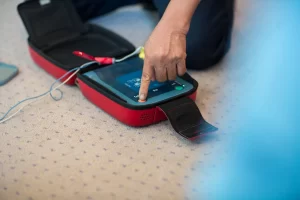
Recent Post
- What Maintenance Is Required for an AED: Everything You Need To Know
November 14, 2025  Could You Recognise the Signs That Someone Needs a Defibrillator?
Could You Recognise the Signs That Someone Needs a Defibrillator?
September 12, 2023
Defibrillators play a vital role in saving lives in Australia’s rural communities. These lifesaving devices are crucial for improving survival rates in cardiac emergency situations.
In rural communities, access to medical facilities and emergency services is often limited, which makes it difficult to provide timely and adequate medical assistance. Therefore, having defibrillators available in public places, such as community centres, sports clubs, and schools, can significantly improve the chances of survival in cardiac emergencies.
Defibrillators are easy to use and provide step-by-step instructions, which means that even people without medical training can use them to save lives. In this article, we discuss the importance of defibrillators in Australia’s rural communities and their role in improving health outcomes.
Understanding The Vital Role Of Defibrillators Rural Communities
In rural communities, timely access to medical assistance can be difficult due to their remote locations. This makes it essential to have defibrillators in these areas, which can help save lives during sudden cardiac arrests. In this section, we will discuss the importance of timely access to defibrillators, the unique health challenges faced by rural communities, and the critical role of defibrillators in cardiac arrest cases.
The Importance Of Timely Access To Defibrillators
Timely access to defibrillators is crucial in a cardiac arrest emergency. Here are some key points to consider:
- Defibrillators can correct abnormal heart rhythms that can cause cardiac arrest, making it essential to use them as soon as possible.
- Studies have shown that for each minute that passes without defibrillation, the chances of survival decrease by around 10%.
- In rural communities, access to healthcare facilities may be limited, which further underscores the importance of having defibrillators available locally.
- Initiating prompt response measures can increase the chances of survival and reduce the likelihood of organ damage.
Rural Communities And Their Unique Health Challenges
Rural communities present specific health challenges, such as:
- Lack of timely access to medical facilities.
- Higher risk of work-related injuries due to the nature of their jobs.
- Scarcity of healthcare professionals.
- Greater prevalence of chronic diseases such as diabetes and hypertension.
These challenges highlight the need for proactive and immediate measures, such as the presence of defibrillators in these communities.
The Role Of Defibrillators In Cardiac Arrest Cases
Defibrillators play a crucial role in cardiac arrest cases, and here are some key points to consider:
- A defibrillator can restore the normal heart rhythm by delivering an electric shock to the heart.
- Defibrillators are easy to use and require minimal training.
- Apart from hospitals and medical clinics, defibrillators should be available in public areas and workplaces.
- The Australian resuscitation council recommends the placement of defibrillators in high-risk areas and all ambulances.
Rural communities face unique health challenges that require prompt and appropriate measures. The availability and accessibility of defibrillators can significantly improve survival rates in cardiac arrest emergencies. It is, therefore, essential to have defibrillators in all public and high-risk areas to ensure timely intervention in life-threatening emergencies.
Defibrillators 101: The Basics Of How They Work
Defibrillators are crucial medical devices that can be lifesaving in emergency situations. As a common sight in hospitals and medical facilities, it’s essential to know the basics of how they work. In this section, we will discuss the key points in understanding the mechanism behind their lifesaving abilities.
How Defibrillators Restore Heart Rhythm
Defibrillators are used in cases of cardiac arrest to restore the normal rhythm of the heart. The device delivers an electric shock to the heart, which coaxes the heart to regain its normal rhythmic beating.
The shock delivered by the defibrillator works by:
- Stopping the chaotic electrical activity in the heart
- Allowing the heart’s natural pacemaker to kick in and restore a regular heartbeat
Defining Ventricular Fibrillation And Ventricular Tachycardia
Ventricular fibrillation (vf) is a state where the heart’s electrical activity becomes disorganised, leading to ineffective contractions. Vf is one of the leading causes of sudden cardiac arrest and can be fatal if not treated promptly.
Ventricular tachycardia (vt) is another heart rhythm disorder that causes the heart to beat too fast, pumping the blood insufficiently throughout the body. This condition is also a leading cause of cardiac arrest.
The Importance Of Early Defibrillation
Early defibrillation is essential in saving a cardiac arrest victim’s life. Delivering defibrillation within the first few minutes of cardiac arrest can increase the survival rate by up to 75%.
Public access defibrillators placed in rural communities play a significant role in improving survival rates. With these devices being portable and easy to use, non-medical personnel, such as bystanders and first responders, can use them effectively in emergency situations.
Understanding the basics of defibrillators’ operation and their lifesaving capabilities is of utmost importance. By recognising ventricular fibrillation, ventricular tachycardia, and the importance of early defibrillation, we can collectively enhance our ability to address instances of cardiac arrest and ensure more successful outcomes.
Defibrillators In Rural Communities: Challenges And Solutions
Rural communities in Australia face significant challenges when it comes to accessing defibrillators. These lifesaving devices can make all the difference in an emergency, but with limited access, many people in rural areas are at a disadvantage. Here, we will explore the challenges faced by rural communities when it comes to defibrillator access and the innovative solutions that are being implemented to improve this accessibility.
Accessibility To Defibrillators In Rural Australia
Access to defibrillators in rural australia is a significant concern as these lifesaving devices are in limited supply and are expensive to purchase. The remoteness of some rural areas means that even if a defibrillator is available, it can take time for emergency services to reach the location.
This situation puts people living in rural communities at risk, particularly those with pre-existing conditions or the elderly.
Challenges Rural Communities Face In Accessing Defibrillators
- Cost: Defibrillators can be extremely expensive, and not every community has the funds to purchase them.
- Limited supply: Many rural communities don’t have access to a defibrillator, and even if they do, the device may be out of date.
- Accessibility: In some cases, rural areas do have defibrillators, but they are not always easily accessible. They may be locked away or located in areas that are hard to reach quickly in an emergency.
Innovative Solutions To Improve Defibrillator Access
The good news is that there are innovative solutions underway to help improve access to defibrillators for rural communities. Here are some examples:
- Community fundraising: Raising funds as a community to purchase a defibrillator can be a successful way to ensure that there is a defibrillator in a community. This strategy is used in many rural areas and can be an effective way to purchase the device.
- Mobile defibrillators: Mobile defibrillator units can be deployed in rural areas as part of emergency services. This strategy brings the defibrillator to the patient rather than the other way around.
- Public access units: Public access units are installed in high-traffic areas such as shopping centres, airports, and train stations. In some cases, these units may be available in rural communities, providing access to a defibrillator in the case of an emergency.
Access to defibrillators in rural is a significant concern. There are several challenges associated with accessing these lifesaving devices. Fortunately, there are innovative solutions being implemented to help improve this accessibility in rural communities. These solutions bring much-needed support to these areas and help to provide peace of mind to those living in rural areas.
Defibrillators In Action: Real-Life Rural Community Cases
Case Studies Of Defibrillator Use In Australian Rural Communities
The use of defibrillators can save lives in rural communities where emergency medical services are often many miles away. Here are three real-life case studies from australia where using a defibrillator made all the difference:
- Case study 1: In a rural town in new south wales, a man collapsed from sudden cardiac arrest while hiking in the mountains. Fortunately, a defibrillator was nearby, and a fellow hiker used it to restart the man’s heart. The man was airlifted to a hospital and made a full recovery.
- Case study 2: In a small farming community in Queensland, a young woman collapsed while playing basketball. A defibrillator was readily available, and the local club president quickly used it to shock her heart back into rhythm. The woman was rushed to a local hospital, where she received further treatment and survived.
- Case study 3: In a remote area of western australia, a man had a heart attack while driving his truck. His passenger was able to pull over and use a defibrillator from the first aid kit to restart his heart. They were both later transported to a regional hospital, where the man received life-saving treatment.
Lives Saved By Timely Defibrillator Use
In rural areas, where medical help can take time to arrive, defibrillators can make the difference between life and death. According to the australian resuscitation council, early defibrillation can increase the chance of survival from sudden cardiac arrest by up to 75%.
Some statistics that underline the importance of timely defibrillation are:
- Every year in australia, approximately 18,000 cardiac arrests occur outside a hospital, and only about 10% of those who have a cardiac arrest survive.
- For every minute that passes without defibrillation, the chance of survival decreases by 10%.
- In rural areas, where emergency services may take up to 45 minutes to arrive, the use of a defibrillator is critical.
By providing easy access to defibrillators and ensuring people are trained to use them, rural communities can significantly increase the odds of saving lives.
The Importance Of Training And Education For Defibrillator Use In Rural Areas
While defibrillators are easy to use, specialised training and education are necessary to equip people with the knowledge and confidence required to use them effectively. In rural areas, where the majority of the population is often older, and access to medical assistance is limited, training and education are even more vital.
Some points that highlight the importance of training and education for defibrillator use in rural areas are:
- Training programs should be put in place to offer lifesaving skills to community members. Proper training ensures that more people are trained with cpr and defibrillation, which could save lives in emergencies.
- People should be regularly updated about any changes in guidelines or best practices, making sure they are prepared to efficiently handle the medical emergency.
- Education holds immense importance in ensuring that people know how to recognise, respond to and deliver aid in an emergency. The correct use of a defibrillator is critical in a cardiac arrest.
By equipping rural communities with the right tools and knowledge, we can save more lives and decrease health disparities by improving health equity throughout the country.
Priority First Aid: Safeguarding Rural Australia One Beat at a Time
Unparalleled Accessibility:
In Australia’s remote rural communities, immediate medical response can be a major challenge. That’s where Priority First Aid comes in. Our extensive range of defibrillators ensures that crucial life-saving technology is within reach, no matter how isolated the location. We provide cutting-edge, easy-to-use defibrillators that are accessible to anyone, even without medical training.
Training and Support:
Recognising the potential knowledge gap, we offer comprehensive training and support services. Our defibrillators are coupled with clear, guided instructions and our team is always ready to provide assistance remotely. This guarantees that every rural community member can effectively use our products in critical moments, bridging the gap between emergency and professional medical help.
Ensuring Rural Resilience:
Our commitment goes beyond just supplying defibrillators; we are actively involved in building healthier, resilient communities. By making life-saving technology accessible and fostering a culture of preparedness, Priority First Aid contributes significantly to the overall resilience of Australia’s rural communities, enhancing their capacity to respond to cardiac emergencies.
Conclusion
Defibrillators are crucial to saving lives in rural australian communities. The implementation of defibrillators in public areas has provided a quick and efficient response to cardiac emergencies, which is particularly important in locations far from hospitals. With the right training and resources, individuals in rural areas can quickly access defibrillators when needed, potentially increasing the likelihood of survival.
It is important to continue to advocate for and invest in the maintenance and accessibility of these lifesaving devices in rural areas. By doing so, communities are better equipped to respond to medical emergencies and save lives. This investment can make a significant difference and is essential for the welfare and safety of people living in rural and remote areas of our country.
Ultimately, the availability of defibrillators will provide a critical bridge to advanced medical care, especially in emergencies that require immediate attention.




